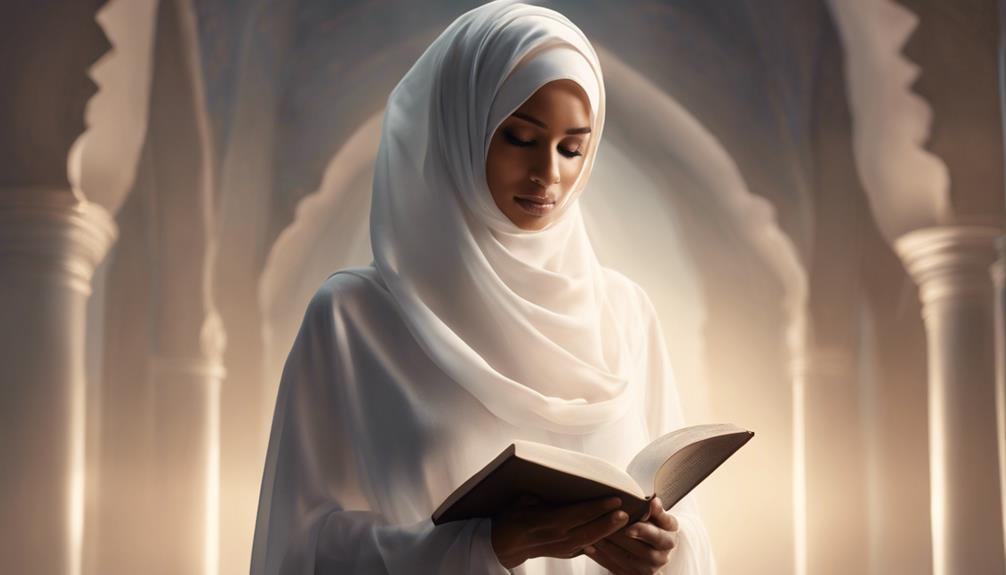Orient meets Occident in a fascinating exploration of veiling, specifically the hijab, within the context of the Bible.

Hijab in the Bible
You've likely noticed the hijab worn by many Muslim women as a sign of modesty and religious devotion. But have you ever considered the concept of veiling in the Bible? References to head coverings in the scriptures of Christianity may surprise you.
Teasing apart cultural traditions from religious mandates, we see a complex picture that blurs the lines between East and West. Intriguing, isn't it?
There's so much more to be unveiled on this topic.
Key Takeaways
- The concept of veiling, akin to the Islamic hijab, has roots in Christian traditions according to biblical references.
- Modesty guidelines, including veiling, vary among Christian denominations as per interpretations of the New Testament.
- Cultural contexts have shaped the practice and interpretation of veiling in Christianity, similar to hijabs in Islam.
- Christian veiling and hijabs have faced both criticism and support, and are viewed differently within feminist perspectives.
Understanding the Concept of Hijab

To grasp the essence of the hijab, it's essential that you delve into its historical, cultural, and religious contexts. The hijab, a veil worn by many Muslim women, isn't merely a piece of cloth. It has profound symbolism and is closely tied to the principles of Islamic feminism.
The hijab's symbolism is multifaceted. It's a declaration of faith, an emblem of modesty, and a shield for purity. It serves as a powerful reminder of a woman's commitment to her religion and her choice to uphold its teachings. This choice, often made in the face of societal pressures, embodies the resilience and strength of Muslim women, thus linking the hijab to Islamic feminism.
Islamic feminism is a form of feminism that seeks gender equality within the framework of Islam. It challenges patriarchal interpretations of Islamic texts and encourages a reinterpretation that promotes women's rights. The hijab, in this context, is seen as a tool of empowerment rather than oppression. It's a symbol of a woman's autonomy, her capacity to make decisions about her body, and her resistance to societal norms that often objectify women.
Biblical References to Veiling

Have you ever wondered about the biblical references to veiling? The act of veiling in the Bible has deep roots, tied to both modesty and symbolism. The biblical context provides a rich backdrop against which we can examine veiling symbolism.
In the Old Testament:
- Genesis 24:65 introduces veiling as Rebekah covers herself upon meeting Isaac.
- Isaiah 3:23 includes veils among the items of luxury and pride that God will strip away.
- Exodus 34:33-35 describes Moses veiling his face after speaking with God, symbolizing a barrier between the divine and the human.
These instances suggest that veiling held varying significance, ranging from modesty, to social status, and even divine interaction.
In the New Testament, veiling predominantly relates to women's modesty and submission. For example, 1 Corinthians 11:5-6 instructs women to cover their heads during worship, reflecting their subordinate position.
The Bible, therefore, provides a multi-faceted view of veiling. It's not a monolithic concept but an evolving one. Understanding veiling in the biblical context sheds light on its complex symbolism and the diverse factors that shaped its usage.
Interpretations of Modesty in Christianity

In Christianity, interpretations of modesty vary widely, influenced by factors such as cultural context, theological understanding, and personal conviction. The concept of modesty has evolved over time, reflected in the Modesty Evolution, from the restrictions of the early church to the diverse expressions of Christian femininity today.
You may find it fascinating to understand how different Christian sects view modesty and the impact of time on these interpretations. Here's a simple table to visualize it:
Christian Sect |
Modesty Interpretation |
|---|---|
Catholicism |
Modest dress, particularly during worship |
Orthodox |
Head coverings for women during worship |
Protestant |
Modesty varies; personal conviction prevalent |
Evangelical |
Emphasis on modesty in all aspects of life |
Pentecostal |
Strict dress codes, including head coverings |
The table represents general trends and not the belief of every individual within these groups. It's essential to remember that personal conviction often plays a significant role in a Christian's expression of modesty. The concept of Christian femininity is much more than clothing; it's about reflecting inner virtues through outward actions and appearances. Modesty, in this sense, is a testament to one's faith and commitment to Christian values.
Cultural Perspectives on Religious Dress

How does cultural context shape our understanding of religious dress? As you navigate the landscapes of religious fashion trends, you'll find that cultural perspectives significantly influence interpretations and practices. This connection is particularly evident in the evolution of religious dress codes.
Cultural norms and values often dictate the form and function of religious attire. For instance, in societies valuing modesty and tradition, religious clothing tends to be more conservative. Conversely, in cultures promoting individualism and modernity, religious fashion may reflect more contemporary styles.
To understand the complex interplay of culture and religious dress:
- Consider the historical context, which often reveals the underpinnings of dress code evolution.
- Analyze the societal norms and values of the culture, as they often dictate the acceptability of specific religious attire.
- Reflect on the influence of globalization and its role in shaping religious fashion trends.
Comparative Analysis: Hijab and Christian Veiling

Delving into a comparative analysis of Hijab and Christian veiling can provide illuminating insights on the nuanced interplay between culture, religious identity, and self-expression. Both practices, while holding unique aspects, share a common thread in the Veiling Symbolism. It's a visible declaration of faith, an embodiment of modesty and a personal commitment to religious principles.
Veiling, however, isn't without its controversies. In some societies, it's been viewed as a tool of oppression, while in others, it's celebrated as an expression of Religious Freedom.
Consider the following table for a concise comparison:
Aspect |
Hijab |
Christian Veiling |
|---|---|---|
Cultural Adaptation |
Middle Eastern |
Western |
Symbolism |
Modesty, piety |
Modesty, submission |
Scriptural Basis |
Quran |
New Testament |
Current Practice |
Widespread |
Limited to certain denominations |
While the Hijab is more widespread, Christian veiling is often limited to specific denominations. Still, both forms of veiling serve as potent symbols of a woman's devotion to her faith, underlining the importance of religious freedom in personal expression. By understanding these comparisons, you're better equipped to appreciate the diversity of religious practices and their cultural implications.
Frequently Asked Questions
How Is the Hijab Perceived in Other Major Religions Apart From Christianity and Islam?
You're inquiring about the perception of the hijab in religions other than Christianity and Islam.
In Judaism, the concept's similar to a 'hijab' but not identical. It's regarded as a sign of modesty and respect, particularly among Orthodox Jews.
The hijab's spiritual significance is also recognized in other faiths, symbolizing humility before God. However, the specifics of this practice can greatly vary between different religious communities.
What Is the Historical Origin of the Hijab in the Middle Eastern Culture?
You're asking about the historical origin of the hijab in Middle Eastern culture.
The hijab's symbolism has evolved over time. Initially, it wasn't a religious icon but a mark of social status.
The practice of veiling gradually morphed into a religious custom, with the spread of Islam.
It's not solely an Islamic practice, as veiling has roots in several cultures and religions.
Are There Any Specific Health or Physical Implications Associated With Wearing a Hijab?
You might wonder if there are health or physical implications of wearing a hijab. Generally, there aren't any major concerns.
However, hijab material choices can affect comfort and heat regulation. Breathable fabrics are preferred to prevent overheating.
Also, hijab sports adaptations have been developed for physical activities. These allow for ease of movement and better air circulation, reducing any potential physical discomfort.
How Does the Hijab Influence the Socio-Economic Status of Women in Predominantly Islamic Societies?
The hijab's economic impact on women's empowerment in predominantly Islamic societies can vary. In some cases, it may limit job opportunities due to societal or employer biases. However, it also fosters a sense of identity and solidarity, potentially opening doors in sectors where modest dress is valued.
It's complex and dependent on various factors, not just the wearing of the hijab itself.
How Does the Current Feminist Movement View the Concept of Hijab and Veiling in Christianity?
The feminist interpretation of Christian veiling varies. Some view it as oppressive, arguing it limits women's freedom and self-expression. Others see it as a means for women to express their devotion and as a symbol of spiritual equality.
It's essential to understand that these views are diverse and often influenced by individual perspectives on feminism and religion. As such, there's no universally accepted feminist perspective on the concept of veiling in Christianity.
Conclusion
In essence, the hijab and Christian veiling share similar roots in promoting modesty and piety. They're both deeply rooted in historical and biblical contexts, interpreted differently across cultures and societies.
It's crucial to respect these practices as expressions of faith, rather than viewing them through a lens of stereotype or cultural misunderstanding. Understanding their shared origins can foster more acceptance and dialogue between Muslim and Christian communities.



Sign up